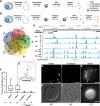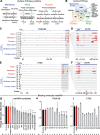Natural display of nuclear-encoded RNA on the cell surface and its impact on cell interaction
- PMID: 32907628
- PMCID: PMC7488101
- DOI: 10.1186/s13059-020-02145-6
Natural display of nuclear-encoded RNA on the cell surface and its impact on cell interaction
Abstract
Background: Compared to proteins, glycans, and lipids, much less is known about RNAs on the cell surface. We develop a series of technologies to test for any nuclear-encoded RNAs that are stably attached to the cell surface and exposed to the extracellular space, hereafter called membrane-associated extracellular RNAs (maxRNAs).
Results: We develop a technique called Surface-seq to selectively sequence maxRNAs and validate two Surface-seq identified maxRNAs by RNA fluorescence in situ hybridization. To test for cell-type specificity of maxRNA, we use antisense oligos to hybridize to single-stranded transcripts exposed on the surface of human peripheral blood mononuclear cells (PBMCs). Combining this strategy with imaging flow cytometry, single-cell RNA sequencing, and maxRNA sequencing, we identify monocytes as the major type of maxRNA+ PBMCs and prioritize 11 candidate maxRNAs for functional tests. Extracellular application of antisense oligos of FNDC3B and CTSS transcripts inhibits monocyte adhesion to vascular endothelial cells.
Conclusions: Collectively, these data highlight maxRNAs as functional components of the cell surface, suggesting an expanded role for RNA in cell-cell and cell-environment interactions.
Keywords: Cell membrane; Cell surface; Cell-environment interaction; Endothelial cells; Extracellular RNA; Monocyte; Single cell.
Conflict of interest statement
S.Z. is a founder and board member of Genemo, Inc.
Figures




Similar articles
-
Single cell RNA-seq resolution revealed CCR1+/SELL+/XAF+ CD14 monocytes mediated vascular endothelial cell injuries in Kawasaki disease and COVID-19.Biochim Biophys Acta Mol Basis Dis. 2023 Jun;1869(5):166707. doi: 10.1016/j.bbadis.2023.166707. Epub 2023 Mar 29. Biochim Biophys Acta Mol Basis Dis. 2023. PMID: 37001702 Free PMC article.
-
Combining single-cell RNA sequencing of peripheral blood mononuclear cells and exosomal transcriptome to reveal the cellular and genetic profiles in COPD.Respir Res. 2022 Sep 20;23(1):260. doi: 10.1186/s12931-022-02182-8. Respir Res. 2022. PMID: 36127695 Free PMC article.
-
Reduction of systematic bias in transcriptome data from human peripheral blood mononuclear cells for transportation and biobanking.PLoS One. 2014 Aug 7;9(8):e104283. doi: 10.1371/journal.pone.0104283. eCollection 2014. PLoS One. 2014. PMID: 25101803 Free PMC article.
-
Heterogeneity of immune cells in human atherosclerosis revealed by scRNA-Seq.Cardiovasc Res. 2021 Nov 22;117(13):2537-2543. doi: 10.1093/cvr/cvab260. Cardiovasc Res. 2021. PMID: 34343272 Free PMC article. Review.
-
[RNA-Seq and its applications: a new technology for transcriptomics].Yi Chuan. 2011 Nov;33(11):1191-202. doi: 10.3724/sp.j.1005.2011.01191. Yi Chuan. 2011. PMID: 22120074 Review. Chinese.
Cited by
-
Mobilization of innate and adaptive antitumor immune responses by the RNP-targeting antibody ATRC-101.Proc Natl Acad Sci U S A. 2022 May 10;119(19):e2123483119. doi: 10.1073/pnas.2123483119. Epub 2022 May 4. Proc Natl Acad Sci U S A. 2022. PMID: 35507878 Free PMC article.
-
Unpacking extracellular vesicles: RNA cargo loading and function.J Extracell Biol. 2022 May 2;1(5):e40. doi: 10.1002/jex2.40. eCollection 2022 May. J Extracell Biol. 2022. PMID: 38939528 Free PMC article. Review.
-
Cell surface-bound La protein regulates the cell fusion stage of osteoclastogenesis.Nat Commun. 2023 Feb 4;14(1):616. doi: 10.1038/s41467-023-36168-x. Nat Commun. 2023. PMID: 36739273 Free PMC article.
-
Cell surface RNAs control neutrophil recruitment.Cell. 2024 Feb 15;187(4):846-860.e17. doi: 10.1016/j.cell.2023.12.033. Epub 2024 Jan 22. Cell. 2024. PMID: 38262409 Free PMC article.
-
Membrane linked RNA glycosylation as new trend to envision epi-transcriptome epoch.Cancer Gene Ther. 2023 May;30(5):641-646. doi: 10.1038/s41417-022-00430-z. Epub 2022 Feb 8. Cancer Gene Ther. 2023. PMID: 35136215 Review.
References
-
- Morozkin ES, Laktionov PP, Rykova EY, Vlassov VV. Extracellular nucleic acids in cultures of long-term cultivated eukaryotic cells. Ann N Y Acad Sci. 2004;1022:244–249. - PubMed
Publication types
MeSH terms
Substances
Grants and funding
LinkOut - more resources
Full Text Sources
Molecular Biology Databases
Miscellaneous

